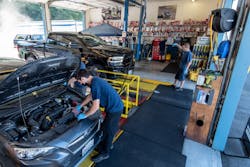With an exponential increase in the amount of customer data available to companies and an ever-growing amount of choice for those customers, tailored shopping and retail experiences have become the norm.
According to a recent survey conducted by research firm Maru, more than 70 percent of respondents said they “want more from their auto shop than regular service alone,” and more than half say they are more likely to return to shops that offer loyalty programs and are active in their communities.
Lynn Malone, owner of the SpeeDee Oil Change and Auto Service in Ruston, La., has only been in the business since August 2021 but says that building customer loyalty and developing relationships is integral to how he runs his shop.
“My philosophy coming into the shop is that we're not in the automotive industry. We are in the customer service business,” Malone says. “We serve our customers by taking care of their automobiles. If we take care of the customer and satisfy their needs, then they'll continue to be customers.”
Curating the shop experience to each individual customer based on their specific consumer history and habits is a daunting task—trying to figure out which data points to track and which to discard can be difficult, and if not done right, spending that much time could still yield very little in the way of positive results.
Andrew Dremak, retention and marketing vice president for MechanicAdvisor, says getting the most valuable information about your customers and using that to tailor their shop experience effectively starts with asking the right questions.
“Whether it’s for repair shops, oil and lube shops or just small businesses in general, you want to know who your customers are and where they're coming from,” Dremak says. “Are they coming for the first time, are they repeat customers? Do they come often? Where are they coming from? Having as much data as possible is very important.”
What to Use, How to Use It
Most shops, regardless of size, will usually keep track of the basics such as customer name, phone number, address and the last service date if the customer isn’t a first-timer.
Aside from service history, though, that information can’t really be used to get to know the customer on a deeper level. Dremak says more useful data that tracks customer habits such as an extensive service history, average ticket for each service and frequency of visits can help shops better curate what kind of messaging a customer receives.
“If we know what the customer is spending on average, we can actually tailor messaging based on that. For instance, if you have customers that only come in for oil changes, they might get certain messaging geared toward spending under a hundred dollars,” Dremak says.
Keeping detailed records can also provide just as much of a service to your customers as it can to your shop. Malone says his shop has already been able to address customer concerns and fraudulent claims with detailed accounts of what his techs have done with each car, make recommendations to customers on products based on their service history, and even help deal with insurance companies.
“A couple of times we've had to provide printed histories for customers who've had insurance claims on warranty work that was done on newer cars, and to satisfy the manufacturer, we provided printed histories of everything that was done to the vehicle in our shop,” Malone says.
Even the way in which customers receive communication from your shop can help elevate their experience when interacting with your shop. Even small things such as keeping track of whether a customer wants to receive an email or a text message can go a long way.
“That's one of our key tenants with our business. We want it to be specific to every customer. That customization gives the customer the power to control the narrative of what's coming to them,” Dremak says. “We don't want to just send blanket texts or emails to customers or blanket emails. We really want it to be a rich experience.”
iPhone over Blackberry
Getting information from customers is one thing and oftentimes is the easy part. Figuring out how to effectively use that data to implement customized strategies for your customers can be a bit trickier.
“I think it would behoove all shops to at least explore what's out there and start to get a finger or, understand a little bit more of a pulse of what's happening and how (Customer Relationship Management software) can work for them,” Dremak says. “It can be daunting to house and make sense of all that data, but systems can help keep track of everything and actually identify customer habits.”
For shops that don’t have the time or resources to dedicate one of their team members to customer service optimization, a third-party solution might be the answer.
Those programs can track detailed information about your customers in real time, down to the specific oil that was put in their vehicle during their last visit or how frequently they’re stopping in, and develop an out-of-shop communication plan to efficiently reach out to those customers based on their preferences.
Shops that handle their communications in-house can still be effective, but oftentimes they don’t have the right tools or knowledge to make best use of customer data. Dremak likens the switch to an outside source to the jump from a Blackberry to an iPhone—one still works, but the other is clearly superior.
“A lot of shops still might be on a Blackberry, and that's okay if they're doing well,” Dremak says, “but they would probably be doing better if they went to the iPhone. They just don't know it yet.”
Take Care of the Customer
Working to customize a customer’s experience with your shop, whether that’s through how you communicate with them or how you suggest new services or products, has never been easier.
“We're in a cool time. These softwares and these different solutions have popped up because we've seen pain points in the shop where we think things could be done easier, and it will save time. We know that, for small business owners, time equals money,” Dremak says. “If you can save time and make communication more effortless, that’s invaluable for these shops.”
Customizing individual emails or text messages may seem a bit granular, and it does raise a simple question: Is it worth the investment?
“The short answer is yes,” Dremak says. “If you know that they come in all the time and what they need, you could give them either an added service that piggybacks off of what they're getting or give them a discount. Something along those lines definitely boosts business.”
And that, Malone says, is what the business is all about.
“If we take care of the customers and take care of their vehicles in a manner that pleases them, then they're going to continue to be repeat customers,” Malone says. “And that's what we're after.”

